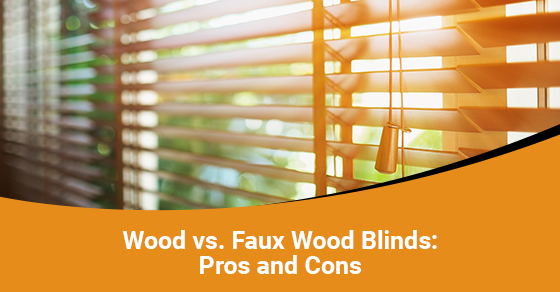
Wood vs. Faux Wood Blinds: Pros and Cons
Blinds come in all different shapes, sizes, and materials. Wood and faux wood blinds are amongst the most popular options for custom window treatments in any home. When it comes to the look, wood can complement your home and bring a touch of rustic, outdoorsy warmth to pretty much any room. While real wood and faux wood blinds each have their benefits, it can be hard to make a decision between the two and understand the implications of choosing one over the other. This is why we’ve come up with some benefits and disadvantages to each so that you can make an informed decision when it comes to custom window treatments. Read below to discover more about the differences and similarities between wood and faux wood blinds.
Placement and Temperature
Whether you choose genuine or faux wood blinds might come down to where your windows are located and, perhaps, the climate of your home. Genuine wood blinds generally require more maintenance than faux wood, and will be susceptible to humidity that you would normally find in bathrooms or kitchens. Humidity and high heat can warp real wood, so it’s best to avoid using genuine wood in warm areas. This is especially true if you live in a tropical region with high heat all year round. In these cases, you might choose to opt for faux wood blinds instead, as they will achieve the look you desire while still being durable and easy to maintain.
Secondly, if you plan on placing blinds in high-traffic areas where there may be kids running around frequently, you might opt again for faux wood blinds. Suppose they happen to get dirty or sustain some damage. In that case, they are cheaper to replace and easier to clean, as you can most likely use household cleaning products without worry. Once again, genuine wood blinds may be beautiful and sophisticated, but they may not suit every home or every area in a home.
Size of Windows
Another factor to consider is the size of your windows. Keep in mind that genuine wood blinds are usually more expensive, so if you are looking at fitting a larger window, you will pay more for this as opposed to using faux wood blinds. On a different note, faux wood blinds are usually made out of composite PVC (polyvinyl chloride), which can be heavier than genuine wood. If you are trying to use faux wood blinds on a large or wide window, operating the blinds may be a struggle due to the extra weight. It is really up to your preference, lifestyle, and budget, as both options can have their benefits and drawbacks.
Home Décor
Now that we’ve covered how wood and faux wood blinds function, let’s discuss their visual appeal and aesthetics. Undeniably, genuine wood blinds are timeless, rich, and organic. The texture will be unique, detailed, and sophisticated for a classic, elegant look that just can’t be duplicated. While it may require some extra care and maintenance, the beauty of real wood is worth it to many. If you have a bit more room in your budget and want the natural appeal, then go for genuine wood blinds.
However, if you are more budget conscious and tend to operate on a busy schedule with no room for extra maintenance, faux wood blinds could be a better option. The good thing about faux wood blinds is that they also come in a variety of colours and stains (as with genuine wood), and can elevate the look of your home since they imitate the natural patterns and texture of real wood. They usually have a lifelike image of wood grain printed on them with an imprinted texture, so you get a similar feel to genuine wood. As long as the faux wood blinds that you choose are of high quality, you shouldn’t have to compromise on style, the richness of colour, or texture.
Insulating Properties
One additional benefit that genuine wood blinds have as opposed to faux wood is that they are naturally insulating and great for those looking for energy efficiency. Genuine wood can provide protection and insulation from the outside elements, while blocking UV rays and keeping energy usage low. If this is something that you value from your window treatments, then genuine wood blinds will be worth it for you.
Price
Lastly, as mentioned previously, genuine wood blinds are generally more costly than faux wood blinds. They are usually sourced from domestic forests and are of high quality, such as oak, cherry, or basswood. You will have to pay more for the authenticity and uniqueness of genuine wood. This all boils down to your personal taste and, of course, your budget.
Choosing the Right Blinds
So, if you love the look of wood tones and texture, rest assured that there are options available even if you don’t want the added responsibility and maintenance of genuine wood. Wooden blinds (whether genuine or faux) offer a classic, stylish touch to any home. They can really serve as a defining feature for your windows, filtering light while evoking warmth and comfort.
For more information on wood blinds and custom window treatments, please call Window Blinds Direct at 647-503-4357 or contact us here. We offer premium, high-quality shades and blinds for whatever your needs may be. Contact us for more information or to request a quote today.

Leave A Comment